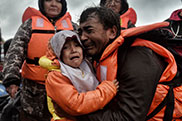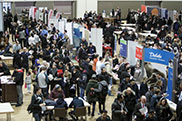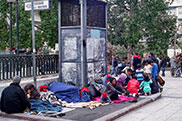 Armend Nimani/Getty Images
Armend Nimani/Getty Images
Article
The results of the nation’s acceptance of refugees from Syria and Iraq reveal just how complicated the world is today.
Learn the why behind the headlines.
Subscribe to the Real Truth for FREE news and analysis.
Subscribe Now“Give me your tired, your poor, your huddled masses yearning to breathe free…” These words, inscribed on a plaque inside the Statue of Liberty in New York City’s harbor, apply to an unlikely place of late: Germany.
The nation is spearheading the Western response to a global refugee crisis. There are an estimated 60 million displaced persons throughout Earth due to war, economic downturn, and environmental disasters.
Last year, Germany took in one million refugees from Asia, Africa and the Middle East. It notably opened its borders to thousands of men, women and children fleeing the conflicts in the majority-Muslim Iraq and Syria—despite Islamic terror attacks throughout the European Union.
Amnesty International dubbed Syria’s civil war the “worst humanitarian crisis of our times.” Others have called it the worst since World War II.
The context of the second world war begins to frame why Germany is leading the charge on accepting refugees.
A Bloomberg opinion piece explained: “The phrase ‘German moral leadership’ may sound strange to many ears, what with the role the country played in two world wars and more recent indignation over the tough stance it took towards Greece’s debt woes. Yet anyone witnessing how the nation has responded to [2015’s] flood of refugees would have to acknowledge that leadership as a fact.
“Why such a transformation has taken place is a tough question to answer, not least because as recently as the 1990s, Germany responded in a far less heroic way to the wave of refugees who fled the war in former Yugoslavia.”
Understandably, Germany wants to land on the right side of history for this issue. Yet taking a central role in accepting refugees has exposed the Gordian-knot complexities of the crisis—both for the nation and the entire world.
Heart-string Motivations
Even a cursory examination of the roiling Syrian civil war proves there are legitimate refugees from the region. Their plight makes it easy to see why nations would provide asylum.
 Aris Messin/Getty Images
Aris Messin/Getty Images
Amnesty International summarized the situation: “Since the crackdown on peaceful protests in March 2011, over 190,000 men, women and children have been killed. 11.6 million people have fled the violence in Syria, a staggering figure almost three times the population of New Zealand.
“What started as a peaceful cry for freedom has descended into a devastating civil war. With an ever-rising death toll and millions left without food, water or healthcare, the people most harmed by the fighting are innocent civilians.”
Each day, an estimated 5,000 people flee their homes in Syria. About four million have inundated nations in the surrounding region.
When people flee war-torn regions of the Middle East—even to Europe—they are likely to wind up in another destitute location filled with continued hardship and heartache.
For Syrians fleeing to Europe, the first step is to get across the border. One path is to migrate north on foot, but others take a shorter yet more dangerous route: small boats from Turkey’s western coast to Greek islands in the Aegean Sea.
According to the International Organization for Migration, more than 3,770 died while crossing the Mediterranean in 2015. Since the start of 2016, about one in every 190 who attempted to cross the sea have not made it.
Those who do land on European soil find themselves on the streets in debt-stricken Greece, where the unemployment rate hovers around 25 percent.
Some, with the hopes of making it to Germany—where jobs are abundant—are left to camp just outside the closed Macedonian border.
The conditions for those living in the makeshift camps grows worse as more people arrive every day. An emergency coordinator for the International Committee of the Red Cross told BBC: “Many people here are soaking wet from having to sleep out in the open; it still dips below 10 [degrees Celsius] here during the night. We are already seeing a lot of flu cases, especially among children, so imagine if they have to sleep outside in the wet again. It could turn into a very serious health problem.”
Immigrants have even created a community out of the former Olympic venues in Turin, Italy. The Guardian reported: “The occupied buildings are in bad condition and need ‘perpetual maintenance’, according to [Nicolo] Vasile, who is…a mechanical engineer. He describes them as permanent, concrete structures with temporary insides and flimsy, plasterboard interior walls. ‘These weren’t built to last forever; they were built for two weeks,’ he says, citing problems with mold, plumbing, and electricity.
“Inside, almost all available space is occupied by mattresses. One of the overcrowded buildings, built to accommodate fewer than 100 athletes during the Games, is now home to as many as 500 people.”
When asked why he chose to live here, one resident of the shelter explained what pushed him to leave Libya: “I stayed to make money [working in a cafe] and send it back to my family [in Senegal]. But then problems increased, everyone had guns in the street…there was no work anymore, no money anymore.”
Back in Idomeni, Greece, where 10,000 migrants camp outside the closed border to Macedonia, a 27-year-old Palestinian man who spent two days trapped in no-man’s land between razor-wire fences said: “This is like something out of the movies. We can’t go to Europe, we can’t go to Greece. Nobody wants us” (Reuters).
Given the situation, German Chancellor Angela Merkel has continually advocated an open-door policy for those fleeing war. She and other EU leaders are working with Turkey to limit the daily flow of new migrants to the continent, however, she stands by her promise to accept those in need.
Another Reason
Beyond humanitarian motivations, there is another reason for Germany’s refugee policies. This time it is more pragmatic: a low birth rate and shrinking workforce numbers means the nation needs more adults.
This necessity caused politicians to coin the term Willkommenskultur, which means “welcome culture.”
 Carsten Koall/Getty Images
Carsten Koall/Getty Images
The Guardian explained the meaning behind the word: “Coined by politicians a few years ago, it was originally meant to be the siren call that would attract people from other countries to come to Germany and compensate for a big shortage of skilled workers in vast, sparsely populated areas such as Brandenburg and Mecklenburg-Vorpommern.
“These days Willkommenskultur is used to encourage help for the hundreds of thousands of refugees coming to Germany. And thousands of Germans have pitched in; they take food and clothes to the camps, take refugees to meetings with the authorities in their own cars, pay their fares, foot their medical bills, teach German, translate forms, share couches and bikes, act as nannies, open up soccer clubs, schools and kindergartens for refugee kids, and go on demonstrations against rightwing attacks across the country.”
Yet the reality of welcoming refugees to fill skilled positions may not be quite as good as it sounded on paper.
The problem with the plan? Politico answered that most refugees “lack the skills German companies need.”
“Let’s not delude ourselves,” Ludger Woessmann, director of Munich-based Ifo Center for the Economics of Education, told the magazine. “From everything we know so far, it seems that the majority of refugees would first need extensive training and even then it’s far from certain that it would work out.”
Politico continued: “Even those with training often don’t have the skills expected in Germany. On average, an eighth-grader in pre-war Syria had a similar level to a third-grade student in Germany, according to the Organisation for Economic Co-operation and Development (OECD).”
Numbers Game
Yet the mass education of refugees is just one problem. Another is the sheer number of people seeking asylum.
The Atlantic put the situation in perspective in its article “The Staggering Scale of Germany’s Refugee Project.” A longer quote from the piece compares what such a massive migration would look like if it occurred in the United States.
“There’s no clear parallel for this sort of influx in the United States. On paper, the U.S. is a giant in the refugee-acceptance business, taking in more refugees than every other country in the world combined, according to Kathleen Newland, a senior fellow and co-founder of the Washington-based Migration Policy Institute. But there’s a difference, she pointed out, between the refugees the United States resettles and the asylum-seekers arriving in Germany. In the former case, individuals are carefully vetted outside the destination country and only then resettled in that country. In the latter, people are flowing over the border—effectively presenting themselves on the ground—and then asking for state protection.”
“‘I think [the distinction is] not widely appreciated,’ said Newland. ‘When Germany says, “We’ll get 800,000 people this year,” these are not people Germany has selected or invited in any way. These people are just turning up.’ In contrast, those accepted by the United States have first been chosen on grounds of particular vulnerability or special ties to the U.S., and then additionally ‘have been through the most lengthy, exhaustive, laborious security screening that you can imagine,’ according to Newland. ‘It usually takes one to two years for someone to get through that process once they’ve been referred for resettlement.’ Germany, she added, is confronting a tremendous immediate challenge to provide these asylum-seekers with food, housing, and ‘weather-appropriate clothing.’
 Milos Bicanski/Getty Images
Milos Bicanski/Getty Images
“In other words, imagine a giant increase in undocumented immigration across America’s southern border. Pew Research has estimated that each year since 2009, an average of roughly 350,000 new unauthorized immigrants have entered the United States. (Net migration is much lower for a variety of reasons, including that a large number of undocumented immigrants are deported every year.) That’s only about 40 percent of the number of asylum-seekers expected to arrive in Germany before the end of the year.
“Now consider what that means proportionally. The United States has close to four times the population of Germany and is almost 28 times bigger territorially. In fact, Germany is much closer in size to California than it is to the United States—a bit smaller in terms of land, but about twice as populous, with a larger economy. In terms of GDP per capita, California was ahead of Germany as of 2014.”
While Germans have tried to remain positive regarding the immigrant influx, there are signs things are changing. According to public broadcaster ARD, 80 percent of Germans think the situation is out of control. Forty percent feel Angela Merkel should resign over the issue, according to a poll in Focus magazine.
Vicious Cycle
Despite noble intentions and potential economic benefits, accepting Muslim refugees brings a host of unintended consequences—especially with Paris’ two Islamic terror attacks not far in the rearview mirror and the Islamic State group promising that more are to come.
The threat of letting terrorists in with legitimate refugees is very real. One of the perpetrators of the Paris attack allegedly came in with a group seeking asylum in the EU. And French President Francois Hollande labeled Syria a “factory of terrorists.”
Sifting through who legitimately needs help and who is ready to strap on a suicide vest is a logistical nightmare.
In addition, mixing European culture with Islam has caused problems for centuries. Each time there is an influx of Muslims, xenophobia rises. Any criminal bad seeds in a group of refugees causes some to paint all of them as religious extremists.
This all perpetuates a vicious cycle.
Any protests by anti-Islam groups in European nations are then used by groups such as the Islamic State as proof the West wants to destroy Muslims. They are then able to recruit more extremists to their cause—which leads to more unrest in the Middle East and more refugees. It also leads to the potential for more terror attacks across the EU.
The reality of war in the 21st century adds even more complications. Military conflict is no longer as simple as Allies versus Axis as it was in World War II. Today, there are competing religious militias, political militias, individual nations, coalitions of nations, and the United Nations all embroiled in long-term conflicts—often with conflicting agendas within each group.
In all of this, if Germany wants to land on the right side of history, it must walk a fine line.
More on Related Topics:
- Germany’s Economy Is Struggling. Here Are 5 Reasons Why
- France Has a New Government, Again. Politics and Crushing Debt Complicate Next Steps
- German Chancellor Loses Confidence Vote, Setting Up an Early Election in February
- French Government Felled in No-confidence Vote, Deepening Political Crisis
- What Does President Biden’s Decision to Allow Ukraine to Use Longer-range U.S. Weapons Mean for the War?


